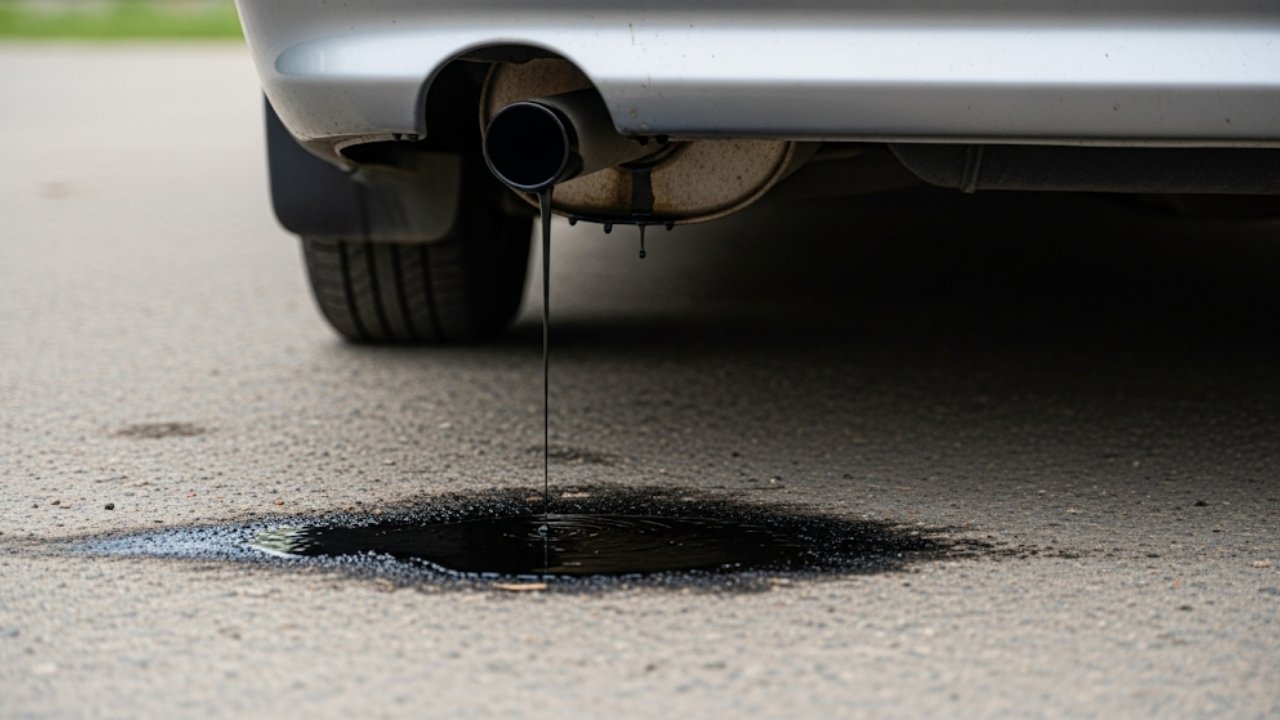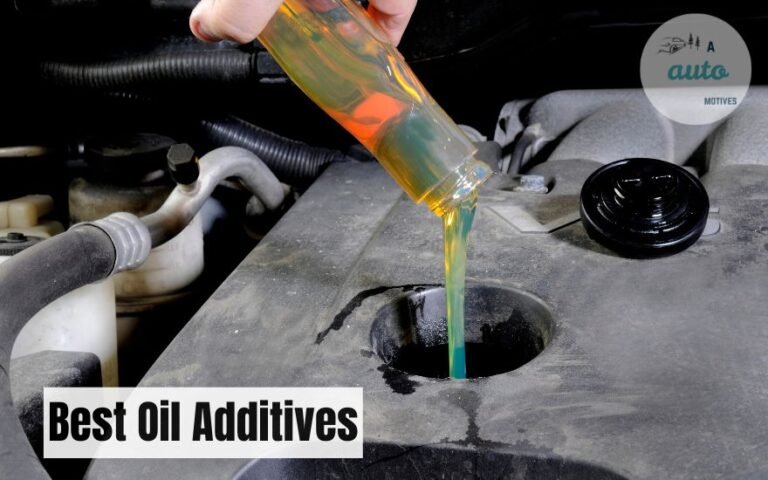Oil Leak from Back of Car: What It Means

You’re backing out of your driveway on a regular morning, coffee in hand, your mind already at work. Then—wait. You glance back and spot it. A dark, greasy puddle. It’s right under the rear bumper. Your heart skips. Your gut clenches. “Is that from my car?”
If you’ve ever spotted an oil leak from back of car, you’re not alone. It’s one of those annoying car problems that sneaks up on you when you least expect it. What’s worse, it often signals trouble—not just a spill.
This article is your full guide. We’ll break it down in plain English: what it means, where it might be coming from, how bad it really is, and what to do next. I’ll even share some of my own awkward car leak moments—so you feel less alone.
Chapter 1: Why an Oil Leak from the Back of Your Car Is So Confusing

But here’s the twist: what looks like an oil leak from back of car might not be coming from the back at all.
Yes, you read that right.
Oil travels. If your car is parked on a slope or slightly downhill, oil leaking from the engine can roll backwards and settle near the rear. Gravity is sneaky like that.
But other times, the leak really is coming from the back. In rear-wheel drive cars or trucks, for example, the differential or rear axle seals might be the source. In SUVs or vans, oil can leak from things like transfer cases or rear-mounted components.
If your fuel tank or brake fluid line is leaking, it can look like oil too—especially when mixed with road grime.
So don’t panic just yet. But don’t ignore it either.
Signs the Leak Is Truly From the Back
Here’s how to tell it’s a real oil leak from back of car and not an illusion:
-
The puddle forms directly under the rear axle or near rear tires
-
You see thick, dark brown or black fluid
-
The leak is ongoing even on flat surfaces
-
You smell burning oil near the rear wheels after driving
Chapter 2: Real-Life Story – My First Rear-End Leak Drama
A couple of years ago, I was driving my dad’s old SUV. The kind that rumbles when it runs. One morning I noticed oil near the rear driver-side wheel. I assumed someone else’s car leaked there.
Fast forward a few days: the SUV started making a low whining sound. Then came the shuddering on turns. I had no clue what was going on.
Turns out, the rear differential was leaking. The fluid had drained so low, the gears inside started grinding. That fix cost me $800.
Moral of the story? If you notice an oil leak from back of car, don’t wait. Even if the car drives “fine,” it could be silently suffering.
Chapter 3: Common Causes of Oil Leak from Back of Car
Let’s break down the possible culprits. Whether you drive a sedan, SUV, or pickup truck—these are the usual suspects:
| Possible Source | Description | Repair Cost Range (USD) |
|---|---|---|
| Rear Differential Seal | Seal around the gear housing in rear-wheel drive cars/trucks. | $150–$600 |
| Axle Seal Leak | The point where the axle meets the differential or wheels. | $100–$300 |
| Transfer Case Leak | Found in AWD or 4WD systems. Holds gear oil or ATF. | $200–$700 |
| Rear Main Seal Leak | Although technically in the rear of the engine, it can drip oil backward. | $600–$1,500+ |
| Fuel Tank Area Leak | Sometimes confused with oil due to its dark, greasy appearance when mixed with dirt. | Varies widely |
| Brake Fluid Leak | May appear oily and collect near rear tires, but usually clearer and thinner than oil. | $100–$500 |
Each of these problems can mimic an oil leak from back of car, so identifying the actual source is key.
Chapter 4: How to Diagnose an Oil Leak at Home
Before you head to a mechanic (and potentially shell out hundreds), you can try a few DIY tricks to confirm where the leak is coming from.
Step-by-Step Diagnosis:
-
Park on a flat surface overnight. Place a piece of cardboard under the entire length of your car. Label the front and back.
-
Check the fluid color. Motor oil is dark brown or black. Transmission fluid is reddish. Brake fluid is clear to yellowish.
-
Smell the leak. Used oil has a burnt, slightly sour scent. Brake fluid is sharper and more chemical-like.
-
Run your finger through it. Motor oil is slick and thick. Brake fluid is more watery.
-
Look under with a flashlight. Check around the rear differential, axle, transfer case, and brake lines.
If the leak is indeed at the rear, congratulations—you’ve narrowed it down to a smaller list.
Still unsure? A professional diagnosis costs far less than a major repair later.
Chapter 5: What Happens If You Ignore It? (Spoiler: Don’t)
It might be tempting to shrug it off. If your car drives fine, why rush?
Here’s why:
-
Gear Damage: If the differential runs dry, metal grinds on metal—eventually destroying it.
-
Loss of Control: Leaking brake fluid near the rear tires can make braking unpredictable.
-
Fire Hazard: In rare cases, leaking oil near hot exhaust components can ignite.
-
Bigger Repairs Later: What could be a $200 seal fix today might become a $1,500 rebuild tomorrow.
I once ignored a small puddle for two weeks. I was busy, stressed, and the car seemed okay. But then—bam. Loud clunking noise on the highway. Differential failure. Cost me over a grand. Never again.
Chapter 6: Can You Drive With an Oil Leak from Back of Car?
Technically, yes—for a short time. But should you?
Only if:
-
The leak is small (just a few drops per day)
-
You know the exact source and risk
-
You’re driving short distances
-
You’re heading straight to a repair shop
Never take long road trips with a known oil leak from back of car. You’re gambling with your safety and your wallet.
Always check your oil level before driving. Top off if needed—but that’s just a Band-Aid.
Chapter 7: How to Temporarily Handle an Oil Leak from Back of Car
Sometimes you’re just not in a position to fix it immediately. Maybe it’s the end of the month, or your mechanic can’t squeeze you in until next week. I get it. Life happens.
While it’s always better to fix a leak properly, there are temporary solutions to slow or manage an oil leak from back of car:
Short-Term Fixes That Work (Sort of)
-
Top off the fluid daily. If it’s your rear differential or axle seal, keep a close eye on the fluid level.
-
Use a stop-leak product. There are products like Bar’s Leaks or Lucas Oil designed to swell seals and reduce minor leaks. Not a permanent fix—but it buys time.
-
Catch the leak. Use a drip tray or cardboard to avoid staining your driveway and to monitor the leak size.
-
Drive less. Cut down on long trips or heavy loads that stress the drivetrain or suspension.
Again, these aren’t solutions. They’re survival tactics. Just don’t forget the golden rule: temporary fixes must never become permanent habits.
Chapter 8: How Mechanics Track Down Rear-End Oil Leaks
Mechanics don’t just glance under the car and go, “Ah-ha!” They use specific techniques to isolate the cause of an oil leak from back of car.
The Process Looks Like This:
-
Pressure Test or Dye Test: Fluorescent dye is added to the oil, then traced under UV light.
-
Degreasing & Cleaning: Mechanics clean the entire area first. That way, they can spot fresh leaks clearly.
-
Jack-Up and Inspect: They raise the car on a lift and visually inspect the differential, seals, fuel tank area, and brake lines.
-
Test Drive: After wiping it down, they’ll often drive it around and re-check for fresh oil spots.
-
Identify Component Type: Whether it’s an axle shaft seal, transfer case, or a failing gasket—each part has a unique failure pattern.
A good shop will explain what’s wrong and show you photos or bring you under the lift to look at it yourself. If they don’t, ask. Your wallet deserves transparency.
Chapter 9: Preventing Future Oil Leaks from the Rear of Your Car
Prevention is way cheaper than repair. And even if your car is older, there are things you can do to delay or avoid leaks altogether.
How to Keep Oil Where It Belongs:
-
Change rear differential fluid regularly. Every 30,000–60,000 miles depending on your vehicle.
-
Check for corrosion. Especially on brake lines or fuel tanks in winter-salt regions.
-
Inspect seals during oil changes. Have the tech check your rear seals and gaskets once a year.
-
Avoid overloading the car. Heavy loads stress rear suspension and driveline components, increasing the chance of leaks.
-
Drive smoother. Aggressive acceleration and braking wear seals faster.
Like maintaining your health with a good diet and daily walk, keeping your car leak-free takes regular TLC.
Chapter 10: Repair vs. Replace – What’s Best?
When you’re dealing with an oil leak from back of car, sometimes it’s a $100 seal. Other times, it’s a $1,500 repair. So the question becomes: fix it—or move on?
When to Repair:
-
Car is under 10 years old and otherwise reliable
-
Leak is minor or medium
-
Repair cost is under 25% of the vehicle’s market value
When to Replace or Sell:
-
The car leaks in multiple places (engine, transmission, differential)
-
Repairs will cost more than half the value of the car
-
You’re tired of ongoing issues and need peace of mind
A mechanic once told me, “If you fix one leak and another shows up next week, your car’s telling you something.” I didn’t listen. I fixed three leaks before realizing it was time to say goodbye.
Sometimes letting go is love too.
FAQs About Oil Leak from Back of Car
1. Can oil leak from the rear of the car even if the engine is in front?
Yes. Oil can travel backward if your car is parked on a slope. Also, rear differentials, axles, and transfer cases (in 4WD vehicles) can leak oil on their own.
2. How do I know if the leak is oil or brake fluid?
Brake fluid is usually clear to light yellow and watery. Oil is darker, thicker, and smells burnt. Rub some between your fingers and check the texture.
3. Can I use stop-leak products for rear-end oil leaks?
Yes, but only for small leaks and as a short-term fix. Products like Lucas or BlueDevil may reduce the leak but won’t solve severe seal failures.
4. Is it safe to drive with an oil leak from the rear?
Only if it’s minor, and you’re checking fluid levels daily. If you hear whining, grinding, or feel vibration—it’s time to stop driving immediately.
5. What happens if I ignore it?
Ignoring a rear-end oil leak can lead to expensive repairs, loss of control while driving, and in some cases, total drivetrain failure.
6. Why does the leak seem worse after driving?
Heat causes oil to thin out and flow more freely. Vibration and pressure can also force oil through small gaps in seals or gaskets.
7. How much does it cost to fix an oil leak from the back of a car?
It depends on the source:
-
Axle seal: $100–$300
-
Differential seal or cover: $150–$600
-
Transfer case gasket: $200–$700
-
Rear main seal: $600–$1,500+
8. Should I clean up the oil myself or leave it?
Clean it up to avoid environmental damage and prevent tracking oil into your home or garage. Use absorbent pads or kitty litter for safe disposal.
Final Thoughts: Don’t Let That Little Puddle Win
Finding an oil leak from back of car isn’t the end of the world. It’s the car’s way of whispering: “Hey, I need a little help here.”
Cars age. Seals wear. Fluids drip. But the key is to listen early, act smart, and don’t let procrastination turn a small drip into a full-blown disaster.
I’ve been there—greasy hands, tight budget, and that feeling of dread as the mechanic gives you “the look.” But once you understand what’s happening under the chassis, it feels a lot less scary.
Your car is more than just metal—it’s your late-night food run partner, your weekend getaway machine, your second home on wheels.
So when it leaks, don’t ignore it. Patch it. Fix it. Or get it the help it needs.
You’ve got this.






